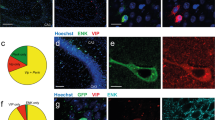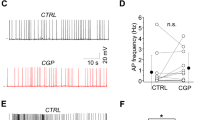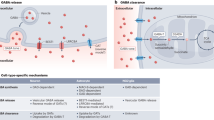Abstract
Neocortical GABA-containing interneurons form complex functional networks responsible for feedforward and feedback inhibition and for the generation of cortical oscillations associated with several behavioural functions1,2. We previously reported that fast-spiking (FS), but not low-threshold-spiking (LTS), neocortical interneurons from rats generate a fast and precise self-inhibition mediated by inhibitory autaptic transmission3. Here we show that LTS cells possess a different form of self-inhibition. LTS, but not FS, interneurons undergo a prominent hyperpolarization mediated by an increased K+-channel conductance. This self-induced inhibition lasts for many minutes, is dependent on an increase in intracellular [Ca2+] and is blocked by the cannabinoid receptor antagonist AM251, indicating that it is mediated by the autocrine release of endogenous cannabinoids. Endocannabinoid-mediated slow self-inhibition represents a powerful and long-lasting mechanism that alters the intrinsic excitability of LTS neurons, which selectively target the major site of excitatory connections onto pyramidal neurons; that is, their dendrites4,5,6,7. Thus, modulation of LTS networks after their sustained firing will lead to long-lasting changes of glutamate-mediated synaptic strength in pyramidal neurons, with consequences during normal and pathophysiological cortical network activities.
This is a preview of subscription content, access via your institution
Access options
Subscribe to this journal
Receive 51 print issues and online access
$199.00 per year
only $3.90 per issue
Buy this article
- Purchase on Springer Link
- Instant access to full article PDF
Prices may be subject to local taxes which are calculated during checkout




Similar content being viewed by others
References
McBain, C. J. & Fisahn, A. Interneurons unbound. Nature Rev. Neurosci. 2, 11–23 (2001)
Freund, T. F. Interneuron diversity series: Rhythm and mood in perisomatic inhibition. Trends Neurosci. 26, 489–495 (2003)
Bacci, A., Huguenard, J. R. & Prince, D. A. Functional autaptic neurotransmission in fast-spiking interneurons: a novel form of feedback inhibition in the neocortex. J. Neurosci. 23, 859–866 (2003)
Thomson, A. M. & Deuchars, J. Synaptic interactions in neocortical local circuits: dual intracellular recordings in vitro. Cereb. Cortex 7, 510–522 (1997)
Tamas, G., Buhl, E. H. & Somogyi, P. Fast IPSPs elicited via multiple synaptic release sites by different types of GABAergic neurone in the cat visual cortex. J. Physiol. (Lond.) 500, 715–738 (1997)
Xiang, Z., Huguenard, J. R. & Prince, D. A. Synaptic inhibition of pyramidal cells evoked by different interneuronal subtypes in layer V of rat visual cortex. J. Neurophysiol. 88, 740–750 (2002)
Williams, S. R. & Stuart, G. J. Dependence of EPSP efficacy on synapse location in neocortical pyramidal neurons. Science 295, 1907–1910 (2002)
Bacci, A., Rudolph, U., Huguenard, J. R. & Prince, D. A. Major differences in inhibitory synaptic transmission onto two neocortical interneuron subclasses. J. Neurosci. 23, 9664–9674 (2003)
Beierlein, M., Gibson, J. R. & Connors, B. W. A network of electrically coupled interneurons drives synchronized inhibition in neocortex. Nature Neurosci. 3, 904–910 (2000)
Yamada, M., Inanobe, A. & Kurachi, Y. G protein regulation of potassium ion channels. Pharmacol. Rev. 50, 723–760 (1998)
Pouzat, C. & Marty, A. Somatic recording of GABAergic autoreceptor current in cerebellar stellate and basket cells. J. Neurosci. 19, 1675–1690 (1999)
Freund, T. F., Katona, I. & Piomelli, D. Role of endogenous cannabinoids in synaptic signaling. Physiol. Rev. 83, 1017–1066 (2003)
Di Marzo, V. et al. Formation and inactivation of endogenous cannabinoid anandamide in central neurons. Nature 372, 686–691 (1994)
Stella, N., Schweitzer, P. & Piomelli, D. A second endogenous cannabinoid that modulates long-term potentiation. Nature 388, 773–778 (1997)
Mackie, K., Lai, Y., Westenbroek, R. & Mitchell, R. Cannabinoids activate an inwardly rectifying potassium conductance and inhibit Q-type calcium currents in AtT20 cells transfected with rat brain cannabinoid receptor. J. Neurosci. 15, 6552–6561 (1995)
Kreitzer, A. C. & Regehr, W. G. Retrograde inhibition of presynaptic calcium influx by endogenous cannabinoids at excitatory synapses onto Purkinje cells. Neuron 29, 717–727 (2001)
Wilson, R. I. & Nicoll, R. A. Endogenous cannabinoids mediate retrograde signalling at hippocampal synapses. Nature 410, 588–592 (2001)
Ohno-Shosaku, T., Maejima, T. & Kano, M. Endogenous cannabinoids mediate retrograde signals from depolarized postsynaptic neurons to presynaptic terminals. Neuron 29, 729–738 (2001)
Losonczy, A., Biro, A. A. & Nusser, Z. Persistently active cannabinoid receptors mute a subpopulation of hippocampal interneurons. Proc. Natl Acad. Sci. USA 101, 1362–1367 (2004)
Trettel, J., Fortin, D. A. & Levine, E. S. Endocannabinoid signaling selectively targets perisomatic inhibitory inputs to pyramidal neurons in juvenile mouse neocortex. J. Physiol. (Lond.) 556, 95–107 (2004)
Piomelli, D. The molecular logic of endocannabinoid signalling. Nature Rev. Neurosci. 4, 873–884 (2003)
Diana, M. A. & Marty, A. Characterization of depolarization-induced suppression of inhibition using paired interneuron–Purkinje cell recordings. J. Neurosci. 23, 5906–5918 (2003)
Kreitzer, A. C., Carter, A. G. & Regehr, W. G. Inhibition of interneuron firing extends the spread of endocannabinoid signaling in the cerebellum. Neuron 34, 787–796 (2002)
Chevaleyre, V. & Castillo, P. E. Heterosynaptic LTD of hippocampal GABAergic synapses: a novel role of endocannabinoids in regulating excitability. Neuron 38, 461–472 (2003)
Cravatt, B. F. et al. Supersensitivity to anandamide and enhanced endogenous cannabinoid signaling in mice lacking fatty acid amide hydrolase. Proc. Natl Acad. Sci. USA 98, 9371–9376 (2001)
Wischmeyer, E., Doring, F. & Karschin, A. Acute suppression of inwardly rectifying Kir2.1 channels by direct tyrosine kinase phosphorylation. J. Biol. Chem. 273, 34063–34068 (1998)
Galarreta, M. & Hestrin, S. A network of fast-spiking cells in the neocortex connected by electrical synapses. Nature 402, 72–75 (1999)
Gibson, J. R., Beierlein, M. & Connors, B. W. Two networks of electrically coupled inhibitory neurons in neocortex. Nature 402, 75–79 (1999)
Tamas, G., Somogyi, P. & Buhl, E. H. Differentially interconnected networks of GABAergic interneurons in the visual cortex of the cat. J. Neurosci. 18, 4255–4270 (1998)
Grenier, F., Timofeev, I. & Steriade, M. Neocortical very fast oscillations (ripples, 80–200 Hz) during seizures: intracellular correlates. J. Neurophysiol. 89, 841–852 (2003)
Acknowledgements
We thank I. Parada for assistance during these experiments, and J. Krey for discussions. This work was supported by grants from the National Institute of Neurological Diseases and Stroke and the Pimley Research Fund.
Author information
Authors and Affiliations
Corresponding author
Ethics declarations
Competing interests
The authors declare that they have no competing financial interests.
Supplementary information
Supplementary Table
LTS, but not FS interneurons decrease their firing frequency during SSI induction. (DOC 26 kb)
Supplementary Figure 1
LTS but not FS neocortical interneurons contain the neuropeptide CCK. (DOC 452 kb)
Supplementary Figure 2
In LTS interneurons the GIRK channel blocker Ba2+reverses both the hyperpolarization and the conductance change associated with SSI while not affecting baseline membrane potential or gm before SSI induction. (DOC 329 kb)
Supplementary Figure 3
The endocannabinoid receptor blocker AM251 applied to LTS interneurons after SSI induction reverses both membrane potential and gm, indicating a persistent CB1 receptor signaling during SSI. (DOC 352 kb)
Supplementary Figure 4
In the presence of the Na+ channel-blocker tetrodotoxin, SSI can be evoked in LTS interneurons by direct depolarization, indicating that Na+ channels are not sufficient to evoke SSI. (DOC 172 kb)
Rights and permissions
About this article
Cite this article
Bacci, A., Huguenard, J. & Prince, D. Long-lasting self-inhibition of neocortical interneurons mediated by endocannabinoids. Nature 431, 312–316 (2004). https://doi.org/10.1038/nature02913
Received:
Accepted:
Issue Date:
DOI: https://doi.org/10.1038/nature02913
This article is cited by
-
Endocannabinoids at the synapse and beyond: implications for neuropsychiatric disease pathophysiology and treatment
Neuropsychopharmacology (2023)
-
Modulatory Activity of the Endocannabinoid System in the Development and Proliferation of Cells in the CNS
Neurotoxicity Research (2022)
-
Age-linked suppression of lipoxin A4 associates with cognitive deficits in mice and humans
Translational Psychiatry (2022)
-
Targeting the endocannabinoid system: a predictive, preventive, and personalized medicine-directed approach to the management of brain pathologies
EPMA Journal (2020)
-
Cannabinoids, TRPV and nitric oxide: the three ring circus of neuronal excitability
Brain Structure and Function (2020)
Comments
By submitting a comment you agree to abide by our Terms and Community Guidelines. If you find something abusive or that does not comply with our terms or guidelines please flag it as inappropriate.



